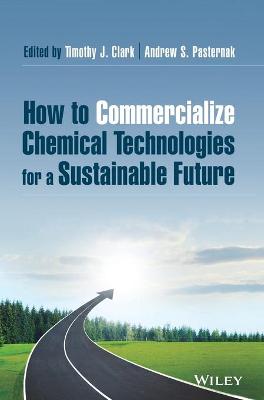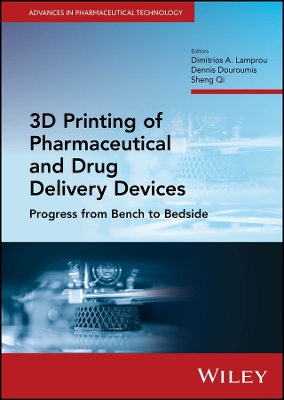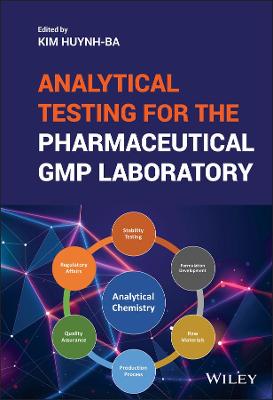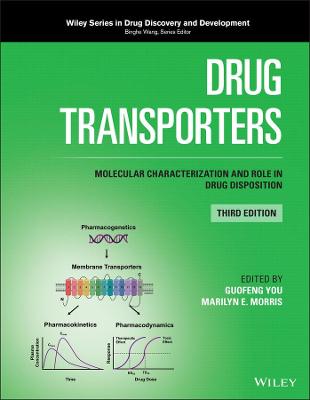How to Commercialize Chemical Technologies for a Sustainable Future
 -15%
portes grátis
-15%
portes grátis
How to Commercialize Chemical Technologies for a Sustainable Future
Pasternak, Andrew S.; Clark, Timothy J.
John Wiley & Sons Inc
06/2021
304
Dura
Inglês
9781119604846
15 a 20 dias
738
1 Introduction 1
Timothy J. Clark and Andrew S. Pasternak
1.1 What Is This Book About? 1
1.2 What Is a Sustainable Chemical Technology? 3
1.3 Commercializing Sustainable Chemical Technologies Is Challenging 4
1.4 Who Should Read This Book? 5
1.5 Structure of This Book 6
1.6 Using This Book 9
Acknowledgments 9
References 9
Part I Laying the Foundation 11
2 Marketing and Landscape Analysis 13
Tess Fennelly
2.1 Introduction: Think Marketing 13
2.2 Creating a Marketing Plan: The Application Framework 15
2.3 Customer Needs and Mapping 15
2.4 Customer Analysis: How to Gather Customer Needs Data 16
2.4.1 Finding the Right Contacts 18
2.4.2 The Interview Form 18
2.5 Customer Needs Mapping 21
2.6 Market Segmentation 22
2.7 Market Segment Evaluation 25
2.8 Competitive Landscape and Competencies 25
2.9 Conclusion and Next Steps 27
3 Determining the True Value of a Sustainable Chemical Technology 31
Lauren Heine and Margaret H. Whittaker
3.1 Introduction 31
3.2 Sustainable Value and the United Nations Sustainable Development Goals 32
3.2.1 Embracing SDGs at the Business Level: United Nations Global Compact Participation 34
3.3 Life-Cycle Thinking and Life-Cycle Assessment 34
3.4 Attributes and Impacts: Check Your Assumptions 35
3.5 Business Risk and Sustainable Design - Or How to Turn an Externality into a Selling Point 37
3.6 Guiding Principles for Sustainable Chemical Technology Innovations: Chemistry, Carbon, and Circularity 39
3.6.1 Sustainable Materials Management 39
3.6.2 Alternatives Assessment 40
3.7 Chemical and Material Considerations that Impact Sustainable Value 42
3.7.1 Chemistry 42
3.7.2 Carbon 46
3.7.3 Circularity 46
3.8 Introducing Your Sustainable Chemical Technology into the Marketplace 47
3.8.1 Communicating Cost Versus Life-Cycle Benefits 47
3.8.2 Benefiting from a "Green Premium" 47
3.8.3 Avoid Greenwashing 48
3.9 Conclusions 49
References 49
4 Intellectual Property Management and Strategy 55
Nick Sutcliffe
4.1 Intellectual Property 55
4.2 What Is an Intellectual Property Right? 56
4.3 The Value of Intellectual Property Rights to a Sustainable Chemical Technology Company 56
4.4 Patents Explained 58
4.4.1 What Sort of Technology Can Be Patented? 58
4.4.2 What Is a Patent? 58
4.4.3 The Patent Bargain 58
4.4.4 Territorial 58
4.4.5 Time Limitation 59
4.4.6 Property 59
4.4.7 Exclusionary Right 59
4.4.8 Criteria for Patentability 59
4.4.9 Preparing and Filing a Patent Application 61
4.4.10 12-Month Anniversary 62
4.4.11 PCT Applications 63
4.4.12 Patent Examiners 63
4.4.13 Patent Examination 63
4.4.14 Grant 64
4.4.15 Renewal Fees 64
4.4.16 Costs 64
4.5 Building an IP Portfolio 65
4.5.1 Invention Management 65
4.5.2 Deciding Whether to File a Patent Application 66
4.5.3 Inventions Not Patentable or Worth Patenting 67
4.5.4 Patent Attorneys/Agents 67
4.5.5 Ownership 68
4.5.6 When to File a Patent Application 68
4.5.7 Where to File a Patent Application? 69
4.5.8 Controlling the Speed of the Process 70
4.5.9 Managing the Patent Application Process 70
4.6 Avoiding Other People's IPRs 71
4.6.1 Freedom to Operate 71
4.6.2 Clearing Obstructions 72
4.6.3 Litigation 73
References 76
Part II Political and Environmental Considerations 79
5 Navigating and Leveraging Government Entrepreneurial Ecosystems for Support 81
Janine Elliott and Rohit Sood
5.1 What Is an Entrepreneurial Ecosystem? 81
5.2 Types of Resources Available 82
5.2.1 Financial Resources 82
5.2.2 Nonmonetary Resources 83
5.3 Ecosystems in the United States and Canada 84
5.3.1 Government Agencies 84
5.3.2 Non-profit Organizations 87
5.3.3 Incubators and Accelerators 88
5.3.4 Academic Research Institutions 89
5.3.5 Investors 90
5.3.6 Hybrids of Resources and Players 90
5.4 Ecosystems in the European Union 91
5.4.1 SusChem: A European Technology Platform of Sustainable Chemistry 92
5.4.2 Entrepreneurial Ecosystem Resources 92
5.4.3 Competitiveness of Enterprises and SMEs (COSME) 93
5.4.4 InnovFin - Financing for Innovators 94
5.4.5 European Innovation Council (EIC) Accelerator 94
5.4.6 Other EU Programs for the Entrepreneur 95
5.4.7 Prizes 96
5.5 Setting Priorities When Pursuing Resources 96
5.6 Conclusion: Engage with Your Ecosystem 98
References 101
6 Factoring in Public Policy and Perception 103
Kira Matus
6.1 Introduction 103
6.2 Chemicals and Policy 104
6.2.1 International Policies 105
6.2.2 Regional Policy - The European Union 106
6.2.3 National-Level Policies 107
6.2.4 Policies Beneath the National Level (US) 109
6.3 New Trends and Approaches 110
6.3.1 The Precautionary Shift 110
6.3.2 Attention to Vulnerable Populations 111
6.3.3 Industry, NGOs, the Public, and Other "Governance" Actors 112
6.3.4 Public Perceptions 113
6.4 Conclusion: Policy as Strategic Advantage for the Sustainable Chemistry Innovator 114
6.4.1 Perceptions and Opportunities 114
6.4.2 Practical Actions 115
Acknowledgments 115
References 115
7 Pre-market Approval of Chemical Substances: How New Chemical Products Are Regulated 119
Richard E. Engler
7.1 Introduction 119
7.2 Overview 120
7.3 United States 121
7.3.1 Federal Food Drug and Cosmetic Act (FFDCA) 121
7.3.2 Federal Insecticide, Fungicide, and Rodenticide Act (FIFRA) 124
7.3.3 Toxic Substances Control Act (TSCA) 125
7.4 European Union (EU) 128
7.4.1 Registration 129
7.4.2 Exemptions to REACH Registration 130
7.5 China 131
7.5.1 Registration 131
7.6 Canada 132
7.7 Developing a Global Strategy 134
7.8 Summary 134
References 135
Part III Springing into Action 137
8 Navigating Supply Chains 139
Tess Fennelly
8.1 Introduction 139
8.2 Supply Chain Complexity 139
8.3 Recognizing Points of View 141
8.4 Supply Chain Hurdles and Strategies to Overcome Them 143
8.4.1 Incumbency: Incumbents and Legacy Suppliers Own the Supply Chain, Market Access, and Global Supply 143
8.4.2 Roadblock: Adoption Must Occur at all Points in the Supply Chain in Order to Be Successful 144
8.4.3 Confusion: "Green Washing," Perceptions, and Misinformation Confuses the Industry and Consumers on What Is Truly More Sustainable, Which Impacts Demand 145
8.4.4 Risk Aversion: Worries of Failure Due to Poor Performance, Brand Tarnishing, Hidden Costs, and Stagnant Product Sales 147
8.4.5 Decision-Makers: Sustainable Corporate Objectives vs. Operations May Not Align 148
8.4.6 Supply and Demand: Concern in Committing to a Single Sourced New Technology 149
8.4.7 Transparency: How to Satisfy Customer and Regulatory Demands While Protecting Intellectual Property and Trade Secrets 149
8.4.8 Price/Performance: It's More Than Price per Pound; Total Cost Savings Need to Be Communicated 151
8.5 Lessons Learned 152
References 152
9 Strategic Partnering 153
Jason Clark and Shawn Jones
9.1 Introduction 153
9.1.1 Partnerships as a Change Driver 153
9.1.2 Partnerships for Sustainable Chemical Technologies 154
9.1.3 Chapter Structure 155
9.2 Advantages and Disadvantages of Strategic Partnering 155
9.3 The Start-Up Perspective: Partnership Advantages and Disadvantages 155
9.3.1 Partnership Advantages for the Start-Up 155
9.3.2 Partnership Disadvantages for the Start-Up 158
9.4 The Industrial Partner Perspective: Partnership Advantages and Disadvantages 159
9.4.1 Partnership Advantages for the Industrial Partner 159
9.4.2 Partnership Disadvantages for the Industrial Partner 161
9.5 Mitigation of the Disadvantages and Risks 163
9.5.1 For the Start-Up 163
9.5.2 For the Industrial Partner 163
9.6 Evaluating a Potential Partnership 164
9.6.1 Start-Up Perspective 164
9.6.2 Industrial Perspective 165
9.7 Establishing the Partnership 166
9.8 Executing the Partnership 167
9.9 Closing the Partnership 168
9.10 Case Studies 169
References 171
10 Bridging the Gap 1: From Eureka Moment to Validation 175
Peiman Hosseini and Harish Bhaskaran
10.1 Introduction 175
10.2 Fundamental Research Leading to an Invention 176
10.3 Proving the Concept 178
10.4 The Tech Team: Moving Beyond an Academic Group 179
10.5 Developing the Road Map 180
10.6 Defining Your Technology Development Requirements 182
10.7 The Innovation Cycle: Design, Simulate, Fabricate, Test, Iterate 184
10.8 Accelerating the Process 186
10.8.1 An Example in Workflow Management 186
10.9 Growing and Evolving the Team 188
10.10 Summary 189
References 190
11 Bridging the Gap 2: From Validation to Pilot Scale-Up 191
11.1 Part 1: Setting the Groundwork 191
James Lockhart and Andrew Ellis
11.1.1 Introduction 191
11.1.2 Letting Go and Obtaining External Expertise 192
11.1.3 Safety Considerations 193
11.1.4 Commercial Considerations 195
11.1.5 Techno-Economic Assessment 197
11.1.6 Conclusion 203
11.2 Part 2: Building the Pilot Unit 205
James Lockhart and Andrew Ellis
11.2.1 Introduction 205
11.2.2 Piloting and Scale-Up Basics 205
11.2.3 Process and Equipment Considerations 210
11.2.4 Pilot Plant Operation and Location 215
11.2.5 Conclusion 218
12 Raising Investment/Financing 219
Matthew L. Cohen
12.1 Introduction 219
12.2 Main Investment Sources 220
12.2.1 Grants 220
12.2.2 Strategic Partnerships 220
12.2.3 Equity Investment 221
12.2.4 Debt 222
12.2.5 Bootstrapping (Using Your Own Money) 223
12.2.6 Summary 224
12.3 Unique Considerations for Investing in Sustainable Chemistry 224
12.3.1 Investment Drivers 225
12.3.2 Investment Impediments 227
12.3.3 Comparison to More Heavily Funded Areas 229
12.4 Financing Considerations 231
12.4.1 Trade-Offs Between Investment Types 232
12.5 Best Practices to Present Your Company to an Investor 235
12.5.1 Summary 236
12.6 Financing Case Study: Cnano Technology 237
Reference 238
13 Operationalizing a Start-Up Company 239
Andrew White
13.1 Introduction 239
13.2 Oversight Boards 240
13.2.1 Advisory Board 240
13.2.2 Board of Directors 241
13.2.3 Building an Advisory Board 242
13.2.4 Building a Board of Directors 242
13.2.5 Managing the Board 243
13.2.6 Compensating Boards 243
13.3 Systems 245
13.3.1 Human Resources Management 245
13.3.2 Health and Safety Systems 247
13.3.3 Financial Systems 248
13.3.4 Financial Projections 250
13.4 Conclusion 253
Part IV Success Stories 255
14 Making an Impact: Sustainable Success Stories 257
14.1 CarbonCure 257
Jennifer Wagner and Sean Monkman
14.1.1 The Vision 257
14.1.2 The Core of the Technologies 257
14.1.3 Determining the Value Proposition 258
14.1.4 The Commercialization Pathway 258
14.1.5 Financing 259
14.1.6 Development and Validation 260
14.1.7 Successes 261
14.1.8 Lessons Learned 262
References 262
14.2 Avantium 263
Gert-Jan M. Gruter and Thomas B. van Aken
14.2.1 Initial Technology and Business Model 263
14.2.2 Change in Direction 264
14.2.3 Exploring and Validating a New Opportunity 265
14.2.4 Huge Challenges and Huge Advances 266
14.2.5 Expanding Our Technology Portfolio 267
14.2.6 Additional Strategies and Lessons Learned 268
14.2.7 Summary 270
References 270
14.3 Hazel Technologies 271
Aidan R. Mouat
14.3.1 Blind Luck or Preparation? 271
14.3.2 Hazel Technologies: How It Started and Where We Are Today 272
14.3.3 Understanding What Our Business Really Is 273
14.3.4 Targeting Value Through the Supply Chain 274
14.3.5 Final Thoughts 276
Index 277
1 Introduction 1
Timothy J. Clark and Andrew S. Pasternak
1.1 What Is This Book About? 1
1.2 What Is a Sustainable Chemical Technology? 3
1.3 Commercializing Sustainable Chemical Technologies Is Challenging 4
1.4 Who Should Read This Book? 5
1.5 Structure of This Book 6
1.6 Using This Book 9
Acknowledgments 9
References 9
Part I Laying the Foundation 11
2 Marketing and Landscape Analysis 13
Tess Fennelly
2.1 Introduction: Think Marketing 13
2.2 Creating a Marketing Plan: The Application Framework 15
2.3 Customer Needs and Mapping 15
2.4 Customer Analysis: How to Gather Customer Needs Data 16
2.4.1 Finding the Right Contacts 18
2.4.2 The Interview Form 18
2.5 Customer Needs Mapping 21
2.6 Market Segmentation 22
2.7 Market Segment Evaluation 25
2.8 Competitive Landscape and Competencies 25
2.9 Conclusion and Next Steps 27
3 Determining the True Value of a Sustainable Chemical Technology 31
Lauren Heine and Margaret H. Whittaker
3.1 Introduction 31
3.2 Sustainable Value and the United Nations Sustainable Development Goals 32
3.2.1 Embracing SDGs at the Business Level: United Nations Global Compact Participation 34
3.3 Life-Cycle Thinking and Life-Cycle Assessment 34
3.4 Attributes and Impacts: Check Your Assumptions 35
3.5 Business Risk and Sustainable Design - Or How to Turn an Externality into a Selling Point 37
3.6 Guiding Principles for Sustainable Chemical Technology Innovations: Chemistry, Carbon, and Circularity 39
3.6.1 Sustainable Materials Management 39
3.6.2 Alternatives Assessment 40
3.7 Chemical and Material Considerations that Impact Sustainable Value 42
3.7.1 Chemistry 42
3.7.2 Carbon 46
3.7.3 Circularity 46
3.8 Introducing Your Sustainable Chemical Technology into the Marketplace 47
3.8.1 Communicating Cost Versus Life-Cycle Benefits 47
3.8.2 Benefiting from a "Green Premium" 47
3.8.3 Avoid Greenwashing 48
3.9 Conclusions 49
References 49
4 Intellectual Property Management and Strategy 55
Nick Sutcliffe
4.1 Intellectual Property 55
4.2 What Is an Intellectual Property Right? 56
4.3 The Value of Intellectual Property Rights to a Sustainable Chemical Technology Company 56
4.4 Patents Explained 58
4.4.1 What Sort of Technology Can Be Patented? 58
4.4.2 What Is a Patent? 58
4.4.3 The Patent Bargain 58
4.4.4 Territorial 58
4.4.5 Time Limitation 59
4.4.6 Property 59
4.4.7 Exclusionary Right 59
4.4.8 Criteria for Patentability 59
4.4.9 Preparing and Filing a Patent Application 61
4.4.10 12-Month Anniversary 62
4.4.11 PCT Applications 63
4.4.12 Patent Examiners 63
4.4.13 Patent Examination 63
4.4.14 Grant 64
4.4.15 Renewal Fees 64
4.4.16 Costs 64
4.5 Building an IP Portfolio 65
4.5.1 Invention Management 65
4.5.2 Deciding Whether to File a Patent Application 66
4.5.3 Inventions Not Patentable or Worth Patenting 67
4.5.4 Patent Attorneys/Agents 67
4.5.5 Ownership 68
4.5.6 When to File a Patent Application 68
4.5.7 Where to File a Patent Application? 69
4.5.8 Controlling the Speed of the Process 70
4.5.9 Managing the Patent Application Process 70
4.6 Avoiding Other People's IPRs 71
4.6.1 Freedom to Operate 71
4.6.2 Clearing Obstructions 72
4.6.3 Litigation 73
References 76
Part II Political and Environmental Considerations 79
5 Navigating and Leveraging Government Entrepreneurial Ecosystems for Support 81
Janine Elliott and Rohit Sood
5.1 What Is an Entrepreneurial Ecosystem? 81
5.2 Types of Resources Available 82
5.2.1 Financial Resources 82
5.2.2 Nonmonetary Resources 83
5.3 Ecosystems in the United States and Canada 84
5.3.1 Government Agencies 84
5.3.2 Non-profit Organizations 87
5.3.3 Incubators and Accelerators 88
5.3.4 Academic Research Institutions 89
5.3.5 Investors 90
5.3.6 Hybrids of Resources and Players 90
5.4 Ecosystems in the European Union 91
5.4.1 SusChem: A European Technology Platform of Sustainable Chemistry 92
5.4.2 Entrepreneurial Ecosystem Resources 92
5.4.3 Competitiveness of Enterprises and SMEs (COSME) 93
5.4.4 InnovFin - Financing for Innovators 94
5.4.5 European Innovation Council (EIC) Accelerator 94
5.4.6 Other EU Programs for the Entrepreneur 95
5.4.7 Prizes 96
5.5 Setting Priorities When Pursuing Resources 96
5.6 Conclusion: Engage with Your Ecosystem 98
References 101
6 Factoring in Public Policy and Perception 103
Kira Matus
6.1 Introduction 103
6.2 Chemicals and Policy 104
6.2.1 International Policies 105
6.2.2 Regional Policy - The European Union 106
6.2.3 National-Level Policies 107
6.2.4 Policies Beneath the National Level (US) 109
6.3 New Trends and Approaches 110
6.3.1 The Precautionary Shift 110
6.3.2 Attention to Vulnerable Populations 111
6.3.3 Industry, NGOs, the Public, and Other "Governance" Actors 112
6.3.4 Public Perceptions 113
6.4 Conclusion: Policy as Strategic Advantage for the Sustainable Chemistry Innovator 114
6.4.1 Perceptions and Opportunities 114
6.4.2 Practical Actions 115
Acknowledgments 115
References 115
7 Pre-market Approval of Chemical Substances: How New Chemical Products Are Regulated 119
Richard E. Engler
7.1 Introduction 119
7.2 Overview 120
7.3 United States 121
7.3.1 Federal Food Drug and Cosmetic Act (FFDCA) 121
7.3.2 Federal Insecticide, Fungicide, and Rodenticide Act (FIFRA) 124
7.3.3 Toxic Substances Control Act (TSCA) 125
7.4 European Union (EU) 128
7.4.1 Registration 129
7.4.2 Exemptions to REACH Registration 130
7.5 China 131
7.5.1 Registration 131
7.6 Canada 132
7.7 Developing a Global Strategy 134
7.8 Summary 134
References 135
Part III Springing into Action 137
8 Navigating Supply Chains 139
Tess Fennelly
8.1 Introduction 139
8.2 Supply Chain Complexity 139
8.3 Recognizing Points of View 141
8.4 Supply Chain Hurdles and Strategies to Overcome Them 143
8.4.1 Incumbency: Incumbents and Legacy Suppliers Own the Supply Chain, Market Access, and Global Supply 143
8.4.2 Roadblock: Adoption Must Occur at all Points in the Supply Chain in Order to Be Successful 144
8.4.3 Confusion: "Green Washing," Perceptions, and Misinformation Confuses the Industry and Consumers on What Is Truly More Sustainable, Which Impacts Demand 145
8.4.4 Risk Aversion: Worries of Failure Due to Poor Performance, Brand Tarnishing, Hidden Costs, and Stagnant Product Sales 147
8.4.5 Decision-Makers: Sustainable Corporate Objectives vs. Operations May Not Align 148
8.4.6 Supply and Demand: Concern in Committing to a Single Sourced New Technology 149
8.4.7 Transparency: How to Satisfy Customer and Regulatory Demands While Protecting Intellectual Property and Trade Secrets 149
8.4.8 Price/Performance: It's More Than Price per Pound; Total Cost Savings Need to Be Communicated 151
8.5 Lessons Learned 152
References 152
9 Strategic Partnering 153
Jason Clark and Shawn Jones
9.1 Introduction 153
9.1.1 Partnerships as a Change Driver 153
9.1.2 Partnerships for Sustainable Chemical Technologies 154
9.1.3 Chapter Structure 155
9.2 Advantages and Disadvantages of Strategic Partnering 155
9.3 The Start-Up Perspective: Partnership Advantages and Disadvantages 155
9.3.1 Partnership Advantages for the Start-Up 155
9.3.2 Partnership Disadvantages for the Start-Up 158
9.4 The Industrial Partner Perspective: Partnership Advantages and Disadvantages 159
9.4.1 Partnership Advantages for the Industrial Partner 159
9.4.2 Partnership Disadvantages for the Industrial Partner 161
9.5 Mitigation of the Disadvantages and Risks 163
9.5.1 For the Start-Up 163
9.5.2 For the Industrial Partner 163
9.6 Evaluating a Potential Partnership 164
9.6.1 Start-Up Perspective 164
9.6.2 Industrial Perspective 165
9.7 Establishing the Partnership 166
9.8 Executing the Partnership 167
9.9 Closing the Partnership 168
9.10 Case Studies 169
References 171
10 Bridging the Gap 1: From Eureka Moment to Validation 175
Peiman Hosseini and Harish Bhaskaran
10.1 Introduction 175
10.2 Fundamental Research Leading to an Invention 176
10.3 Proving the Concept 178
10.4 The Tech Team: Moving Beyond an Academic Group 179
10.5 Developing the Road Map 180
10.6 Defining Your Technology Development Requirements 182
10.7 The Innovation Cycle: Design, Simulate, Fabricate, Test, Iterate 184
10.8 Accelerating the Process 186
10.8.1 An Example in Workflow Management 186
10.9 Growing and Evolving the Team 188
10.10 Summary 189
References 190
11 Bridging the Gap 2: From Validation to Pilot Scale-Up 191
11.1 Part 1: Setting the Groundwork 191
James Lockhart and Andrew Ellis
11.1.1 Introduction 191
11.1.2 Letting Go and Obtaining External Expertise 192
11.1.3 Safety Considerations 193
11.1.4 Commercial Considerations 195
11.1.5 Techno-Economic Assessment 197
11.1.6 Conclusion 203
11.2 Part 2: Building the Pilot Unit 205
James Lockhart and Andrew Ellis
11.2.1 Introduction 205
11.2.2 Piloting and Scale-Up Basics 205
11.2.3 Process and Equipment Considerations 210
11.2.4 Pilot Plant Operation and Location 215
11.2.5 Conclusion 218
12 Raising Investment/Financing 219
Matthew L. Cohen
12.1 Introduction 219
12.2 Main Investment Sources 220
12.2.1 Grants 220
12.2.2 Strategic Partnerships 220
12.2.3 Equity Investment 221
12.2.4 Debt 222
12.2.5 Bootstrapping (Using Your Own Money) 223
12.2.6 Summary 224
12.3 Unique Considerations for Investing in Sustainable Chemistry 224
12.3.1 Investment Drivers 225
12.3.2 Investment Impediments 227
12.3.3 Comparison to More Heavily Funded Areas 229
12.4 Financing Considerations 231
12.4.1 Trade-Offs Between Investment Types 232
12.5 Best Practices to Present Your Company to an Investor 235
12.5.1 Summary 236
12.6 Financing Case Study: Cnano Technology 237
Reference 238
13 Operationalizing a Start-Up Company 239
Andrew White
13.1 Introduction 239
13.2 Oversight Boards 240
13.2.1 Advisory Board 240
13.2.2 Board of Directors 241
13.2.3 Building an Advisory Board 242
13.2.4 Building a Board of Directors 242
13.2.5 Managing the Board 243
13.2.6 Compensating Boards 243
13.3 Systems 245
13.3.1 Human Resources Management 245
13.3.2 Health and Safety Systems 247
13.3.3 Financial Systems 248
13.3.4 Financial Projections 250
13.4 Conclusion 253
Part IV Success Stories 255
14 Making an Impact: Sustainable Success Stories 257
14.1 CarbonCure 257
Jennifer Wagner and Sean Monkman
14.1.1 The Vision 257
14.1.2 The Core of the Technologies 257
14.1.3 Determining the Value Proposition 258
14.1.4 The Commercialization Pathway 258
14.1.5 Financing 259
14.1.6 Development and Validation 260
14.1.7 Successes 261
14.1.8 Lessons Learned 262
References 262
14.2 Avantium 263
Gert-Jan M. Gruter and Thomas B. van Aken
14.2.1 Initial Technology and Business Model 263
14.2.2 Change in Direction 264
14.2.3 Exploring and Validating a New Opportunity 265
14.2.4 Huge Challenges and Huge Advances 266
14.2.5 Expanding Our Technology Portfolio 267
14.2.6 Additional Strategies and Lessons Learned 268
14.2.7 Summary 270
References 270
14.3 Hazel Technologies 271
Aidan R. Mouat
14.3.1 Blind Luck or Preparation? 271
14.3.2 Hazel Technologies: How It Started and Where We Are Today 272
14.3.3 Understanding What Our Business Really Is 273
14.3.4 Targeting Value Through the Supply Chain 274
14.3.5 Final Thoughts 276
Index 277
















